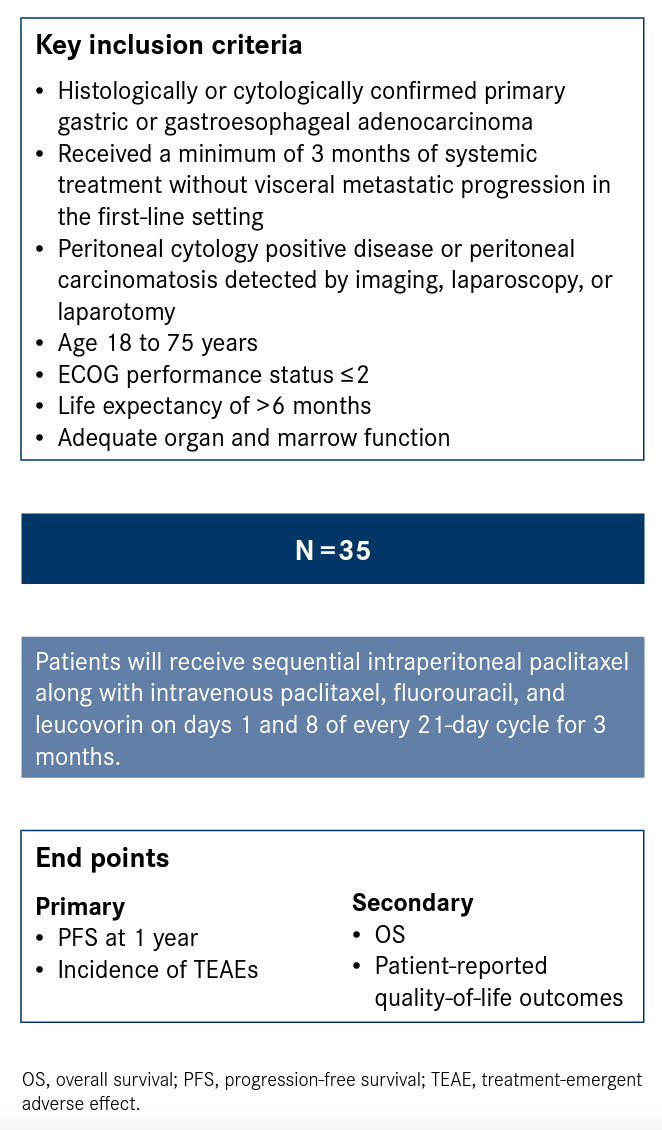Publication
Article
Intraperitoneal Chemotherapy Technique Aims to Dramatically Improve Outcomes in Gastric Carcinomatosis
Author(s):
A novel approach to chemotherapy administration in advanced gastric cancer that has progressed to gastric carcinomatosis is poised to alter the treatment landscape and improve outcomes for this patient population.
Maheswari Senthil, MD, FACS

Patients with advanced gastric cancer that has progressed to gastric carcinomatosis have traditionally lacked effective treatment options with a poor survival outlook.1 However, a novel approach to chemotherapy administration in the disease space is poised to alter the treatment landscape and improve outcomes for this patient population.
The phase 2 STOPGAP trial (NCT04762953) will assess the safety and efficacy of sequential chemotherapy administered intravenously followed by intraperitoneal chemotherapy with paclitaxel. This approach has not been evaluated for patients with stage IV gastric cancer that has progressed to gastric carcinomatosis in the United States.
“In gastric cancer, the likelihood of peritoneal carcinomatosis is very high compared with other gastrointestinal malignancies; it is approximately 30% to 50%,” Maheswari Senthil, MD, FACS, said in an interview with OncologyLive®. “The unique aspect of peritoneal carcinomatosis is that the peritoneum is a [highly] protected cavity. The penetration of [the peritoneal cavity with] chemotherapy agents is limited because of the blood-peritoneal barrier.... Although systemic chemotherapy administered intravenously is extremely important, it may not have adequate penetration to treat the carcinomatosis part of the disease.”
Senthil is the principal investigator on the STOPGAP trial. She is also the director of the Peritoneal Malignancy Program at the Chao Family Comprehensive Cancer Center, chief of the Division of Surgical Oncology, and a clinical professor of surgery at the school of medicine at the University of California, Irvine.
Palliative intravenous chemotherapy and/or best supportive care is the current standard for patients with gastric peritoneal carcinomatosis. The median overall survival (OS) for this patient population is approximately 7 months. In a retrospective analysis by Rau et al, 19 patients with peritoneal metastases of gastric cancer treated between August 2008 and December 2017 received systemic chemotherapy alone. These patients experienced a median OS of 4.9 months, and the 1-year survival rate was 0%.2
International Findings With Intraperitoneal Chemotherapy Are Promising
Intraperitoneal chemotherapy for gastric cancer with peritoneal carcinomatosis has been evaluated in multiple clinical trials in Asia. A phase 2 clinical trial from Singapore and Japan has evaluated the safety and efficacy of intraperitoneal paclitaxel as well as intraperitoneal docetaxel.3
In this study, 40 patients received intraperitoneal paclitaxel at a dose of 20 mg/m2 and 50 mg/m2 of intravenous paclitaxel administered on days 1 and 8. The oral fluoropyrimidine derivative S-1 was also given at a dose of 80 mg/m2 daily for 14 consecutive days, followed by 7 days of rest. Patients experienced a median OS of 22.6 months, with a 1-year OS rate of 78%.3 Findings from Yamaguchi et al showed that the same treatment regimen administered to 35 patients elicited a median OS of 17.6 months, with a 1-year OS rate of 77% and a 2-year OS rate of 45%.
Imano et al reported findings from an intensive paclitaxel regimen—intraperitoneal paclitaxel at 80 mg/m2 followed by S-1 80 mg/m2 daily for 14 consecutive days. Intravenous paclitaxel 50 mg/m2 was given on days 1 and 8. The median OS was 21.3 months and the 1-year and 2-year OS rates were 69% 46%, respectively.3 Finally, in results from Fushida et al and Fujiwara et al, intraperitoneal docetaxel administered in doses ranging from 35 mg/m2 to 60 mg/m2 in combination with S-1, the median OS was 24.6 months and 16.2 months, respectively.
In terms of tolerability, Senthil noted that no unique trends in adverse effects were reported with intraperitoneal administration. “Extrapolating the data from the Asian studies that have extensively used paclitaxel for intraperitoneal administration, this is a very well-tolerated treatment,” she said. “[Additionally], some patients in the Asian studies received [intraperitoneal chemotherapy] for multiple cycles—[some up to 20 cycles], just repeated intraperitoneal administration. The tolerability and extension of use of intraperitoneal chemotherapy could be even more than what we are projecting in STOPGAP.”
Following these encouraging phase 2 data, Japanese investigators initiated the phase 3 PHOENIX-GC trial (UMIN000005930) in patients with gastric cancer with peritoneal metastasis. In the study, the efficacy of intraperitoneal paclitaxel plus systemic S-1 and paclitaxel (n = 114) was compared with standard systemic chemotherapy (n = 50). Patients enrolled in the trial had received no prior therapy or short-term chemotherapy defined as less than 2 months. The primary end point was OS and secondary end points included overall response rate and safety.4
Findings from the trial showed that the median OS in the investigational arm was 17.7 months (95% CI, 14.7-21.5) compared with 15.2 months (95% CI, 12.8-21.8) in the control arm (HR, 0.72; 95% CI, 0.49-1.04; P = .08). The 3-year OS rates were 21.9% (95% CI, 14.9%-29.9%) and 6.0% (95% CI, 1.6%-14.9%). Both regimens were well tolerated. the findings were maintained across subgroups with the largest benefit observed in those with moderate amount of ascites (HR, 0.38;95% CI, 0.16-0.90; P = .03) and women (HR, 0.55; 95% CI, 0.32-0.95; P = .03).
Study authors concluded that although the superiority in terms of OS of intraperitoneal paclitaxel plus systemic chemotherapy was statistically insignificant compared with the standard of care, exploratory analyses suggested potential clinical benefits of intraperitoneal paclitaxel in gastric cancer.
STOPGAP Aims to Improve Options in Gastric Cancer
The STOPGAP trial is currently recruiting, and investigators seeking to enroll approximately 35 adult patients with primary gastric or gastroesophageal adenocarcinoma with cytology-positive peritoneal lavage and/or peritoneal carcinomatosis. Eligible patients must have an ECOG performance status of 2 or less, adequate organ and marrow function as defined by investigators, and a life expectancy greater than 6 months (Figure5).
Figure. STOPGAP Phase 2 Trial Design5

Patients will be excluded from the trial if they have received systemic treatment for more than 3 months preceding enrollment. Those who have undergone prior surgery that would preclude safe diagnostic laparoscopy and port placement, have evidence of a distant solid organ metastases, or have an active infection that mandates systemic therapy are also not eligible.
“STOPGAP will help us truly understand the subgroup of patients [with gastric cancer] for whom we are able to [generate] the maximum effect in their OS,” Senthil said. “That would help us create even more knowledge about which set of patients benefit from this approach. Then [we would] be able to design the next clinical trial that highly selects for these patients with certain predictive markers, and clinical features that are necessary to derive the most benefit.”
Initially, patients in the single-arm, nonrandomized, open-label trial will receive systemic therapy for 3 months at the clinician’s discretion based on molecular biomarkers. Patients will then undergo diagnostic laparoscopy followed by intraperitoneal port placement.
Investigators will treat patients with an intravenous chemotherapy regimen of paclitaxel, f luorouracil, and leucovorin. Paclitaxel will also be instilled into the peritoneal cavity through the intraperitoneal port at a dose of 40 mg/m2. Treatment will be administered on days 1 and 8 of each 21-day cycle for 3 months.
Four to 6 weeks following the completion of intraperitoneal chemotherapy, restaging imaging will be performed using CT scan and/or diffusion-weighted MRI with contrast. Diagnostic laparoscopy will also be used to assess peritoneal disease burden and treatment response. Patients will then be assigned to a treatment plan based on their response to treatment and extent of disease. If a patient experiences stable disease or a response and a peritoneal cancer index (PCI) score greater than 10, they will continue treatment with the intraperitoneal chemotherapy regimen; patients with disease progression will transition to a second-line regimen; and patients with a response and a PCI score of 10 or less for whom complete cytoreduction is feasible will be considered for cytoreduction with intraperitoneal chemotherapy.
The primary end points of the study are 1-year PFS. Secondary end points include OS and patient-reported quality-of-life outcomes. Other outcome measures include expression of plasma and ascites exosomal gene signature (EXOSIG) and EXOSIG to treatment response. Study authors estimate that the trial will be completed in June 2025.
“There are implications from this study that could be extrapolated to other cancers,” Senthil said. “The general concept of normothermic intraperitoneal chemotherapy is something that we will take away from the study. Right now, normal thermic intraperitoneal chemotherapy is not routinely administered in patients with carcinomatosis. then we should be expanding this approach to other diseases for which it can be applied. I am looking forward to a future where we can customize treatment approaches for individual patients.”
The trial is open for enrollment.
References
- Senthil M. Ph II trial of sequential systemic therapy + intraperitoneal paclitaxel in gastric/GEJ cancer. UCI Center for Clinical Research. Accessed August 30, 2022. bit.ly/3CGZjWe
- Rau B, Brandl A, Thuss-Patience P et al. The efficacy of treatment options for patients with gastric cancer and peritoneal metastasis. Gastric Cancer 2019;22(6):1226-1237. doi:10.1007/s10120019-00969-1
- Kono K, Yong WP, Okayama H, et al. Intraperitoneal chemotherapy for gastric cancer with peritoneal disease: experience from Singapore and Japan. Gastric Cancer. 2017;20(suppl 1):122-127. doi:10.1007/ s10120-016-0660-y
- Ishigami H, Fujiwara Y, Fukushima R, et al. Phase III trial comparing intraperitoneal and intravenous paclitaxel plus S-1 versus cisplatin plus S-1 in patients with gastric cancer with peritoneal metastasis: PHOENIX-GC trial. J Clin Oncol. 2018;36(19):1922-1929. doi:10.1200/JCO.2018.77.8613
- Study of sequential systemic therapy + intraperitoneal paclitaxel in gastric/GEJ peritoneal carcinomatosis (STOPGAP). ClinicalTrials.gov. Updated March 9, 2021. Accessed August 30, 2022. https://www. clinicaltrials.gov/ct2/show/NCT04762953










